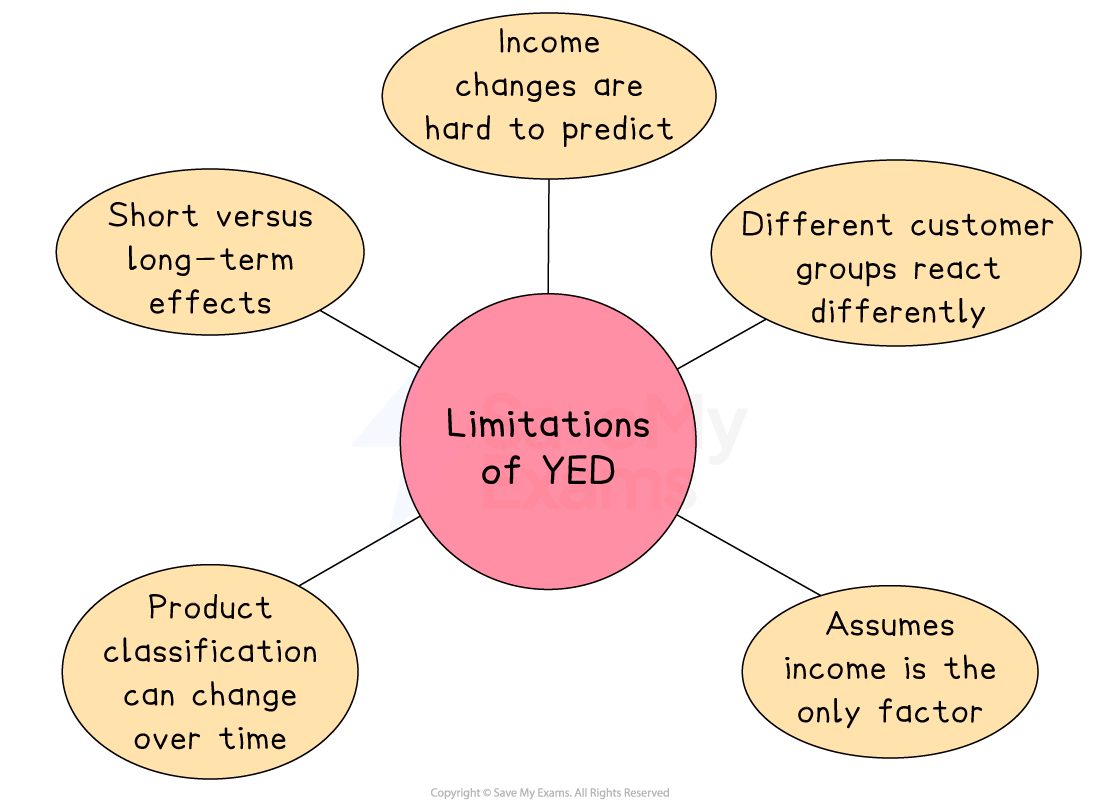Income Elasticity of Demand (Cambridge (CIE) A Level Business): Revision Note
Exam code: 9609
The concept of income elasticity of demand
Income elasticity of demand (YED) measures the responsiveness of demand for a product to a change in income levels
Businesses are interested in how much the quantity demanded will change for different products
When household incomes change, spending on goods and services will either increase or decrease, depending on the type of good or service it is
Normal good: A good where demand rises when income increases, e.g. restaurant meals or new clothes
Inferior good: A good where demand falls when income increases, e.g. instant noodles or bus travel
Luxury good: A good where demand increases more than proportionally as income increases, e.g. designer handbags or sports cars
Calculating and interpreting income elasticity of demand
The YED value can be positive or negative, and the value is important in determining the type of good
A good with a positive YED value is considered to be a normal good
Normal goods can be classified as necessities or luxuries
A good with a negative YED value is considered to be an inferior good
YED is calculated using the formula
Worked Example
An individual’s income falls from £450 to £405 per week. As a result, their demand for takeaway meals falls from 50 to 30 per week.
Calculate the income elasticity of demand (YED) for takeaway meals.
[4]
Step 1: State the YED formula
(1)
Step 1: Calculate the % change in QD
(1)
Step 2: Calculate the % change in Y
(1)
Step 3: Insert the above values in the YED formula
(1)
Influences on YED
YED is influenced by many factors in an economy that change the wages of workers
During a recession, wages usually fall and demand for inferior goods rises while demand for luxury goods falls
During a period of economic growth and rising wages, demand for luxury goods increases while demand for inferior goods decreases
Other influences on income include minimum wage legislation, taxation and increased international trade
Understanding the income elasticity of demand is useful to businesses, as it can help them plan their production and products
Planning in this way will help them generate higher profits and be less exposed to economic downturns
Interpreting YED values
YED is more than 1 and positive
Normal good
Examples: cars, foreign holidays, cinema visits and branded goods
Demand rises when income rises
Demand falls when income falls
Demand is responsive to a change in income (income elastic)
YED is between 0 and 1 and positive
Necessity good
Examples: bread, milk, fuel, toothpaste
Demand rises slightly as income rises
Demand falls slightly as incomes fall
Demand is not very responsive to a change in income (income inelastic)
YED is negative
Inferior good
Examples: public transport, domestic holidays, canned foods, own-label goods
Demand rises when income falls
Demand falls when income rises
Negative income elasticity
The impact of income elasticity of demand on decisions
Pricing and promotion
Firms can anticipate changes in demand when incomes rise or fall:
Products with high positive YED (luxury goods) will see demand increase more than proportionally as income rises
During a downturn, demand for such products may fall sharply, so businesses may need to lower prices or offer discounts
For necessities (low YED, close to zero), demand is less sensitive to income, so businesses can maintain prices even in economic downturns
Product and capacity planning
Positive income elasticity signals a non-necessity or luxury item, where sales rise as incomes rise
Burberry enjoys strong growth when wages improve, so the firm expands its high‑end ranges and store space
Negative income elasticity identifies inferior goods
Supermarket "value" noodles sold more during the 2022–23 cost‑of‑living squeeze, so factories increased night shifts to cope
Oatly’s premium oat milk drink saw fast UK sales growth as incomes recovered in 2024, so the brand invested in a new Peterborough packing facility
Marketing objectives
Firms set objectives using elasticity estimates
B&Q identified that spending on DIY products is income elastic, so it continued to add products to its portfolio during the recent economic downturn
Inventory and production schedules
Knowing that Pumpkin Spice Lattes have a high positive PED but a strong seasonal YED, Starbucks launches them every August and adjusts its coffee bean orders months ahead
Risk management
Airlines such as Ryanair use dynamic pricing models built on PED estimates
If a flight is 80% full, prices rise sharply because late bookers are less price‑sensitive
Examiner Tips and Tricks
If you're using PED or YED data, don’t stop at calculating it
Always say how it affects pricing or sales decisions
Limitations of income elasticity of demand
Income elasticity of demand helps businesses understand if their product is a luxury, necessity or inferior good
However, just like with PED, there are limits to how useful YED is when making business decisions
Key limitations of YED

Income changes are hard to predict
It’s difficult to know exactly when or how much people’s income will rise or fall
E.g. A sudden cost-of-living crisis could reduce incomes and demand for luxury items faster than expected
Different customer groups react differently
Not everyone’s income changes in the same way, so demand might not shift evenly
E.g. A business may target high earners, but average YED data includes lower-income groups too
Assumes income is the only factor
YED focuses on income changes but ignores other factors like trends, advertising or substitutes
E.g. A healthy food company may see demand rise due to a trend, not just because incomes have increased
Product classification can change over time
A product that is seen as a luxury today might become a necessity tomorrow
E.g. Smartphones were once luxuries, but now they are widely considered to be essential
Short-term versus long-term effects
Demand might react slowly to income changes, especially if customers delay spending
E.g. After getting a pay rise, an individual may not upgrade their car straight away

Unlock more, it's free!
Did this page help you?